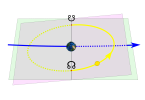When watching a basketball game, you may notice that players are often credited with assists for passing the ball to a teammate who scores. But what exactly counts as an assist in basketball? The rules for what qualifies as an assist can vary depending on the league or organization keeping track of stats, but there are some general guidelines that can help you understand what counts as an assist.
In most cases, an assist is awarded to the player who passes the ball to a teammate who then scores a basket without dribbling. The pass must be a direct one and the scoring player must make the basket immediately after receiving the pass.
Additionally, the passer must have made a significant contribution to the basket, meaning that the pass must have helped create the scoring opportunity. However, there are some exceptions to these rules, which we will explore in more detail in this article.
Definition of an Assist in Basketball
In basketball, an assist is a statistic that tracks a pass that leads directly to a made basket by a teammate. It is a way to measure a player’s ability to create scoring opportunities for others on the court.
To be counted as an assist, the pass must meet the following criteria:
- The pass must be intentional and not a result of a deflection or a rebound.
- The pass must lead directly to a made basket, meaning the recipient of the pass must score without taking additional dribbles or moves.
- The scorer must make a “basketball move” after receiving the pass, such as a layup, dunk, or jump shot.
It’s important to note that an assist is only awarded if the scorer’s shot is successful. If the shot is missed, no assist is given, even if the pass met all the other criteria.
Assists are typically credited to the player who made the final pass, but there are some exceptions. For example, if a player makes a pass that leads to a foul and free throws, they can still be credited with an assist if the free throws are made.
Overall, assists are an important part of basketball and can be a key indicator of a player’s ability to create scoring opportunities for their teammates.
Recording an Assist
Assists are an important stat in basketball that recognize a player’s contribution to a scoring play. In this section, you will learn about the rules for recording an assist and the role of the scorekeeper.
Official Statistic Rules
According to the NBA’s official rules, an assist is awarded to a player who passes the ball to a teammate who then scores a field goal. The pass must be intentional and lead directly to the score without the receiver dribbling the ball or making any other significant movement.
There are a few exceptions to this rule. A player can still receive an assist if the receiver takes one dribble before scoring, as long as the pass was still a significant factor in the play. Additionally, a player can receive an assist if the receiver is fouled after receiving the pass and makes at least one free throw.
Scorekeeper’s Role
The scorekeeper is responsible for tracking all stats during a game, including assists. The scorekeeper must pay close attention to each play and determine whether a pass meets the criteria for an assist.
To record an assist, the scorekeeper must first identify the passer and the receiver. The scorekeeper should then note the time of the pass and the time of the score. If the pass meets the criteria for an assist, the scorekeeper should record it in the official scorebook.
It’s important for the scorekeeper to be accurate and consistent when recording assists. This ensures that players receive credit for their contributions to the game and that the stats accurately reflect the outcome of the game.
In conclusion, recording an assist in basketball requires a clear understanding of the official rules and the scorekeeper’s role. By following these guidelines, you can ensure that assists are accurately recorded and players receive credit for their contributions to the game.
Types of Assists
When it comes to basketball, an assist is a crucial statistic that measures a player’s ability to create scoring opportunities for their teammates. There are two main types of assists: primary assists and secondary assists.
Primary Assist
A primary assist is when a player passes the ball to a teammate who then scores a basket without any additional passes or dribbles. This is the most common type of assist and is usually the result of a well-executed play or a great pass.
To be credited with a primary assist, the pass must be the direct reason why the basket was scored. For example, if a player passes the ball to a teammate who then takes a few dribbles before scoring, the passer will not be credited with a primary assist.
Secondary Assist
A secondary assist, also known as a hockey assist, is when a player passes the ball to a teammate who then passes it to another teammate who scores a basket. This type of assist is less common but still important as it shows a player’s ability to create opportunities for their teammates indirectly.
To be credited with a secondary assist, the pass must be the second-to-last pass before the basket is scored. This means that if a player passes the ball to a teammate who then passes it to another teammate who passes it to the scorer, the first passer will not be credited with a secondary assist.
Overall, both primary and secondary assists are important for a team’s success. A player who can create scoring opportunities for their teammates is a valuable asset to any team.
Factors Influencing an Assist
When it comes to basketball, an assist is one of the most important stats that a player can have. It is a record of a player’s ability to create scoring opportunities for their teammates. However, not every pass that leads to a basket is counted as an assist. In this section, we will discuss the factors that influence an assist.
Player’s Actions
The actions of the player who makes the pass play a significant role in determining whether or not an assist is awarded. The following actions are usually considered when determining an assist:
- The pass must be intentional and accurate.
- The pass must lead directly to a made basket.
- The pass must not be followed by excessive dribbling or movement by the recipient of the pass.
- The pass must not be a result of a shot attempt that missed the basket.
Team Strategy
The team’s strategy also influences the number of assists a player can get. Some teams prefer isolation plays, where one player dominates the ball and creates scoring opportunities for themselves.
In such cases, it can be challenging for other players to get assists. On the other hand, teams that emphasize ball movement and sharing the ball tend to have more players with high assist numbers.
Game Situation
The situation in the game can also affect the number of assists a player can get. In a fast-paced game with a lot of scoring, players are more likely to get assists.
When the game is close and the score is low, players may be more focused on scoring themselves rather than creating opportunities for their teammates.
In conclusion, several factors influence whether or not a pass is counted as an assist. The player’s actions, team strategy, and game situation all play a role in determining this important stat. Understanding these factors can help players and coaches develop strategies to maximize their assist numbers.
Controversies and Debates
When it comes to basketball assists, there are always debates and controversies surrounding what should and shouldn’t count as an assist. Here are some of the most common controversies:
1. Scorekeeper Bias
One of the biggest controversies in basketball is the potential for scorekeeper bias. This occurs when a scorekeeper gives an assist to a player they favor, even if the pass wasn’t necessarily an assist. This can be frustrating for players who feel they deserved an assist but didn’t get one due to scorekeeper bias.
2. Passes Leading to Free Throws
Another controversy in basketball is whether or not a pass leading to free throws should count as an assist. Some argue that the player who made the pass should get credit for the assist, while others believe that a pass leading to free throws is not a true assist.
3. Scoring Errors
Scoring errors can also lead to controversies in basketball. For example, if a player makes a pass that leads to a basket, but the basket is later credited to another player, the original passer may not receive credit for the assist. This can be frustrating for players who feel they deserved an assist but didn’t get one due to a scoring error.
4. Self-Passes
Finally, there is debate about whether or not self-passes should count as assists. Some argue that a self-pass is not a true assist because the player who passed the ball also scored the basket. Others believe that a self-pass should count as an assist because it still involved a pass that led to a basket.
Overall, while there are controversies and debates surrounding what counts as an assist in basketball, it is important to remember that the goal of an assist is to credit the player who made the pass that led to a basket. As long as the pass meets that criteria, it should be counted as an assist.
Evolution of the Assist Statistic
When basketball was first invented, there was no formal way of tracking assists. It wasn’t until the 1940s that the statistic was officially recognized and recorded. Since then, the definition of what counts as an assist has evolved over time.
In the early days of basketball, assists were only given if the pass directly led to a made basket. But as the game evolved and became more complex, so did the definition of an assist.
In the 1960s, the NBA began to recognize assists for passes that led to free throws. By the 1970s, assists were also given for passes that led to a shot attempt that missed but resulted in an offensive rebound and a subsequent score.
In the 1980s, the NBA began to track secondary assists, also known as hockey assists, which are passes that lead to the pass that directly leads to a score.
This was a significant development in the evolution of the assist statistic, as it recognized the importance of ball movement and teamwork in creating scoring opportunities.
In recent years, the NBA has continued to refine the assist statistic. In 2013, the league began tracking potential assists, which are passes that would have been an assist if the recipient of the pass had made the shot. This statistic helps to recognize players who make good passes even if their teammates fail to convert the opportunity into points.
Overall, the evolution of the assist statistic reflects the changing nature of basketball and the growing recognition of the importance of teamwork in creating scoring opportunities.
Conclusion
In conclusion, understanding what counts as an assist in basketball is crucial for both players and fans. As we have seen, the definition of an assist is when a player passes the ball to a teammate who then scores a basket without dribbling.
It is important to note that not all passes that lead to a basket are considered assists. For example, if a player passes the ball to a teammate who then dribbles and creates their own shot, that is not considered an assist.
Additionally, there are some instances where an assist may not be awarded even if a player passes the ball to a teammate who scores. This can happen if the pass is deemed to be too difficult or if the player who receives the pass takes too many dribbles before scoring.
Overall, understanding what counts as an assist can help players improve their passing skills and help fans appreciate the teamwork and strategy involved in the game of basketball. Remember, passing is just as important as scoring in basketball, and a well-executed assist can be just as exciting as a dunk or a three-pointer.







